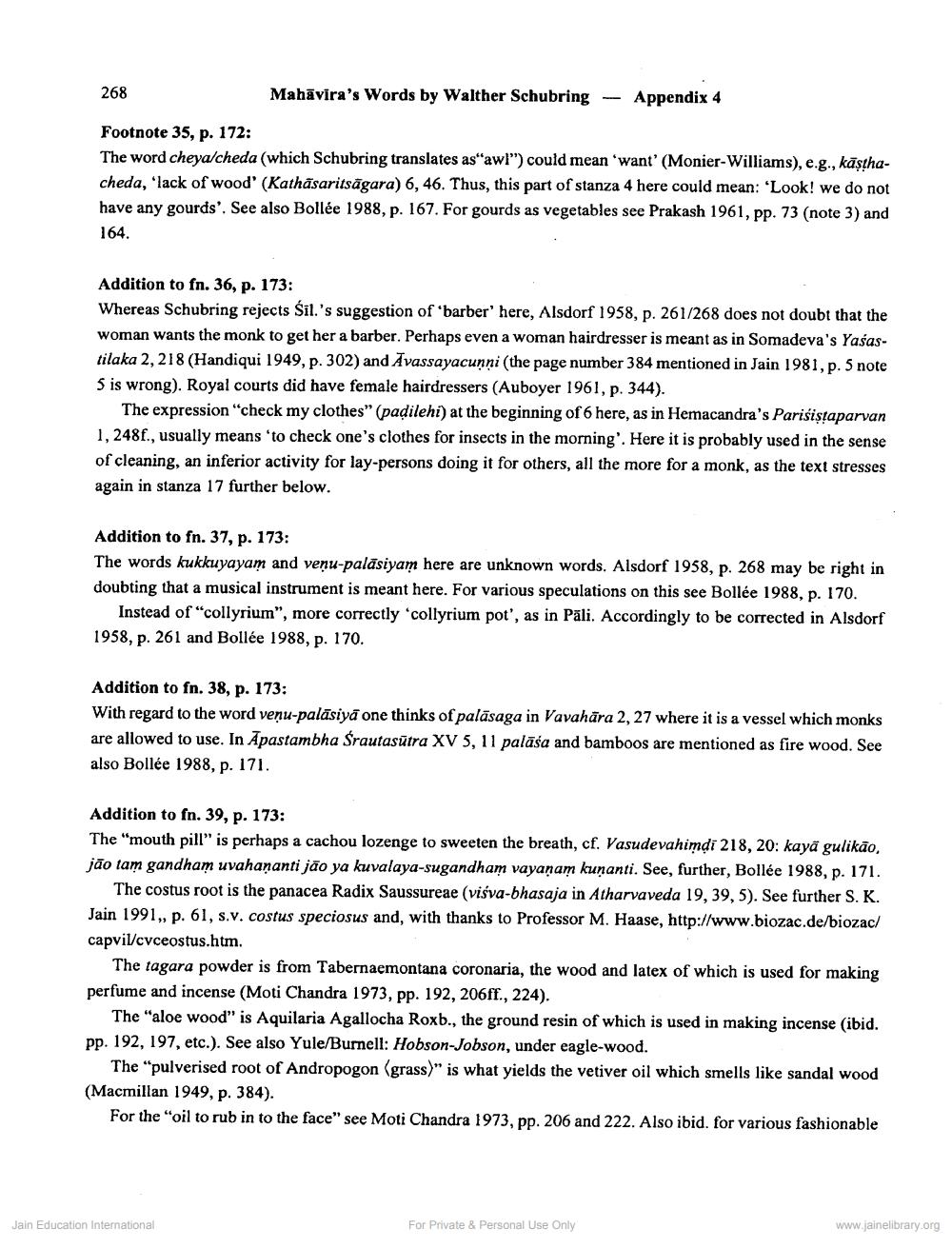________________
268
Mahavira's Words by Walther Schubring
Footnote 35, p. 172:
The word cheya/cheda (which Schubring translates as"awl") could mean 'want' (Monier-Williams), e.g., kāṣṭhacheda, 'lack of wood' (Kathasaritsägara) 6, 46. Thus, this part of stanza 4 here could mean: 'Look! we do not have any gourds'. See also Bollée 1988, p. 167. For gourds as vegetables see Prakash 1961, pp. 73 (note 3) and 164.
Appendix 4
Addition to fn. 36, p. 173:
Whereas Schubring rejects Sil.'s suggestion of 'barber' here, Alsdorf 1958, p. 261/268 does not doubt that the woman wants the monk to get her a barber. Perhaps even a woman hairdresser is meant as in Somadeva's Yasastilaka 2, 218 (Handiqui 1949, p. 302) and Avassayacunni (the page number 384 mentioned in Jain 1981, p. 5 note 5 is wrong). Royal courts did have female hairdressers (Auboyer 1961, p. 344).
The expression "check my clothes" (paḍilehi) at the beginning of 6 here, as in Hemacandra's Parisistaparvan 1,248f., usually means 'to check one's clothes for insects in the morning'. Here it is probably used in the sense of cleaning, an inferior activity for lay-persons doing it for others, all the more for a monk, as the text stresses again in stanza 17 further below.
Addition to fn. 37, p. 173:
The words kukkuyayam and venu-palasiyam here are unknown words. Alsdorf 1958, p. 268 may be right in doubting that a musical instrument is meant here. For various speculations on this see Bollée 1988, p. 170.
Instead of "collyrium", more correctly 'collyrium pot', as in Pali. Accordingly to be corrected in Alsdorf 1958, p. 261 and Bollée 1988, p. 170.
Addition to fn. 38, p. 173:
With regard to the word veņu-palasiya one thinks of palāsaga in Vavahāra 2, 27 where it is a vessel which monks are allowed to use. In Apastambha Śrautasutra XV 5, 11 palasa and bamboos are mentioned as fire wood. See also Bollée 1988, p. 171.
Jain Education International
Addition to fn. 39, p. 173:
The "mouth pill" is perhaps a cachou lozenge to sweeten the breath, cf. Vasudevahimḍī 218, 20: kayā gulikão, jão tam gandham uvahaṇanti jão ya kuvalaya-sugandham vayanam kuṇanti. See, further, Bollée 1988, p. 171.
The costus root is the panacea Radix Saussureae (visva-bhasaja in Atharvaveda 19, 39, 5). See further S. K. Jain 1991,, p. 61, s.v. costus speciosus and, with thanks to Professor M. Haase, http://www.biozac.de/biozac/ capvil/cvceostus.htm.
The tagara powder is from Tabernaemontana coronaria, the wood and latex of which is used for making perfume and incense (Moti Chandra 1973, pp. 192, 206ff., 224).
The "aloe wood" is Aquilaria Agallocha Roxb., the ground resin of which is used in making incense (ibid. pp. 192, 197, etc.). See also Yule/Burnell: Hobson-Jobson, under eagle-wood.
The "pulverised root of Andropogon (grass)" is what yields the vetiver oil which smells like sandal wood (Macmillan 1949, p. 384).
For the "oil to rub in to the face" see Moti Chandra 1973, pp. 206 and 222. Also ibid. for various fashionable
For Private & Personal Use Only
www.jainelibrary.org




